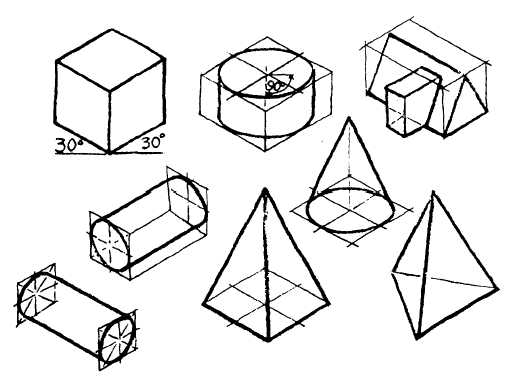Figure 5-70.-Basic isometric forms.
isometrically for a model, you should draw an
oblique sketch following the basic steps shown in
figure 5-69, view B.
The first step is to draw a rectangle of the front
view (using light lines). Then, second, draw an
oblique base line at a 45-degree angle starting at
the corner (intersection) of the horizontal and
vertical base lines. Third, sketch the remaining
horizontal and vertical lines parallel to the other
base lines. Fourth, erase any unnecessary lines,
and fifth, dimension and darken the completed
drawing for easier reading. Remember, place the
dimensions so they are parallel to the axis lines.
The final step is to check the sketch for
completeness and accuracy.
In the above procedures for development of
pictorial sketches, a simple rectangular form was
used. All objects may be simplified to their basic
geometric forms. These forms are the first
consideration in the pictorial sketch. Basic
volumetric forms are shown in figure 5-70. By
carefully analyzing any object you sketch, you will
see one or more of the forms shown in figure 5-70.
However, at times only a part of a form is present.
Before attempting detailed sketches, practice
sketching the basic forms. Then look for these
forms in the object you are about to sketch, and
concentrate on the basic form representation.
Enclose the object in a basic form, or build
it up with a series of different forms, depending
on the nature of the object. Details are added or
“carved” from these forms after shape and
proportion have been determined.
Overlay Sketches
To make OVERLAY SKETCHES, sketch
freehand on transparent paper placed over existing
drawings or other sketches. Sometimes when you
make overlay sketches, you merely trace, free-
hand, objects or lines from another drawing
or sketch. But more often you will prepare
overlay sketches by tracing and then adding
supplementary sketched lines or objects.
Usually, when this type of sketch is prepared,
only the prominent or desired features are
traced. Overlay sketches are primarily used for
planning purposes.
A suggested procedure for using overlay
sketches as a tool for planning is explained in the
following example:
The drafting room is being relocated. You are
tasked with developing a proposed furniture and
equipment layout. You have the latest prints of
the floor plan and an electrical plan, and you
5-36



